vgthought.com
Flow in Kirby Platforming
Posted: 2014-01-13 22:18:37
Last edited: 2014-02-24 00:12:34
Last edited: 2014-02-24 00:12:34
I wrote this one around 2008 or 2009.
The main argument here is that Kirby's Adventure forces the player to stop and engage in uninteresting gameplay. On the other hand, Kirby's Dream Land 3 employs platforming in one of two modes: simplistic segments the player can breeze through without stopping and tense segments where the player must move forward thoughtfully.
Be on the lookout for unfounded assertions about Mega Man and Mario, and don't mind if the term "flow" never gets defined. Still, you'll get analysis of specific moments in Kirby games.
The main argument here is that Kirby's Adventure forces the player to stop and engage in uninteresting gameplay. On the other hand, Kirby's Dream Land 3 employs platforming in one of two modes: simplistic segments the player can breeze through without stopping and tense segments where the player must move forward thoughtfully.
Be on the lookout for unfounded assertions about Mega Man and Mario, and don't mind if the term "flow" never gets defined. Still, you'll get analysis of specific moments in Kirby games.
In Kirby games, there seem to be two main approaches to level design. Kirby’s Adventure and Kirby’s Dreamland 3 are the most striking examples to me personally–these are two games I know particularly well. My experience with other Kirby games suggests that they are all consistent with this pattern, but I choose to compare these two simply because I’ve played them the most. I prefer Kirby’s Dreamland 3, so please pardon the bias–even if you disagree with me, I believe there’s something to take away from this article.
The first approach to level design, which appears more often in Kirby games, is a simplistic version of a Mega Man level design philosophy. Blocks are placed in order to throw enemies precisely at you. In a Mario sidescroller, most of the enemies are just along the way rather than purposely in your path (read: the Hammer Bros are an exception here), but in Kirby, the platforms are arranged in a specific way so as to throw enemies at you. This is simplified by two main things. First, enemies almost never have a strong attack pattern (barring bosses). Often, enemy attacks are easy to see coming and easy to avoid. Second, petty enemies are never strong. You would be hard-pressed to find an enemy that doesn’t die with one hit. It’s possible in Kirby Super Star to damage an enemy without killing it, but more often than not your attacks will kill an enemy with one hit.
Enemies are simple, and while the platforming does go to some extent to throw them at you, it hardly creates a challenging situation; you’re left with platforms that make a small effort to put you in harm’s way and enemies that make a small effort to attack you.
This first screen shot from Kirby’s Adventure demonstrates the idea well:
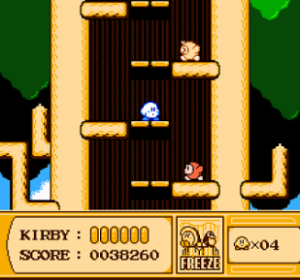
First of all, the platforming here doesn’t flow. As you jump up through this sequence of platforms, you’re forced to wait at each step of the way for the enemy on the platform above you. The enemies and blocks are placed such that there’s no way to weave in and out of them, so you’ve got to stop and take note of what they’re doing. If the tree itself was horizontally wider or the space between platforms was vertically wider, your range of movement would be larger and it would be possible to keep moving at a consistent pace. Additionally, there’s no solid challenge here; the timing isn’t difficult. You wait for the enemy above you to fall to your level, attack the enemy, jump up to the next platform, wait for the next enemy to fall, and so on, until you reach the top of the tree.
The story continues in screenshot 2.
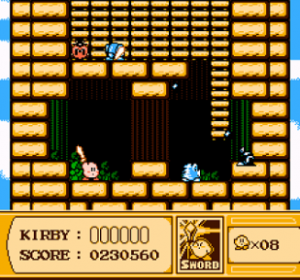
Things are a little more difficult here. The hothead in the bottom right corner is tricky to get to, since you either have to attack him from above or hope to slide into the hole when he’s at the opposite end of it. The hole is also placed in a crucial spot. Being able to enter it would make climbing the ladder easier; once in the hole, jumping past the cannonballs from the shotzo is simpler. This is because you can stand directly under the ladder; if you cannot get in the hole, you must cover both horizontal and vertical distance to reach the ladder. This is one scenario in which the platforming creates a challenge; rather than waiting, the player must find a way to proceed.
In Kirby’s Adventure, situations similar to screenshot 2 are few and far between.
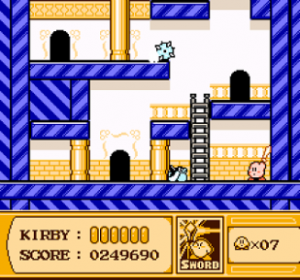
On the other hand, Kirby’s Adventure has a good number of situations like this. Here, platforms really seem to be present only to get you from point A to point B. They aren’t placed with any sense of flow, mostly due to their close proximity, producing a claustrophobic feel much like the first screenshot in this article. Enemies are also largely unavoidable–you hardly have space to jump over that pengy at the bottom when the ceiling is either 32 or 48 pixels (the height of 2 or 3 blocks) from the floor. However, combatting pengy is just a matter of stopping Kirby and pressing the B button (for almost all of the powers in the game). The combat is not complex, yet the design forces the player into it. The platforming also hardly makes the combat difficult. Unlike the situation in screenshot 2, pengy should prove to be no problem, and the same goes for the togezo up there. However, the platforms halt any flow as is; enemies only exaggerate the stop and go pace of the design.
Kirby’s Dreamland 3 takes a different approach. Rather than taking platforming and simplifying it somewhat, it has two distinct platforming styles: sometimes it has incredibly simplistic platforming that generates a sense of flow, and other times it has distinct, colorful platforming (again, think of screenshot 2).
Let me show you what I mean by incredibly simplistic platforming:
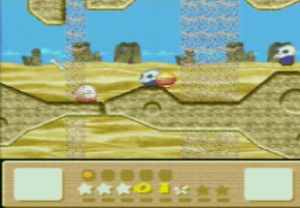
This is more than just simple, it’s simple with a sense of flow. Note the frequent use of slopes. While slopes are present in Kirby’s Adventure, they are not nearly as prevalent there as they are in Kirby’s Dreamland 3. Here, the jumping involved is minimal–perhaps you want to jump to hit the gabon and sasuke in the middle, but it’s not so imperative to jump as when there’s no slope; when there is no slope, you absolutely must jump. In this screenshot, however, you can jump to hit enemies or dodge their attacks, but there’s no need to jump just to get over the hills. It’s also possible just to run forward and attack enemies without jumping, considering it is possible to avoid their attacks this way. By removing the need to jump over blocks, the player has more freedom in when he or she jumps, aiding the player in creating a sense of flow–it’s all about reacting to enemies and charging ahead, as opposed to the stop-and-start jumps you see in the first and third screenshots from Kirby’s Adventure. The addition of slopes is important to differentiate it from a flat plain, as well. Slopes spruce up gameplay by changing elevation. You don’t meet every enemy head-on; you have to adjust for change in elevation, which can prove tricky at times. For example, gabon will throw bones at you in an arc, rather than straight at you. On a flat plain, you might stand at a safe distance and attack him; however, with a slope, it’s possible to walk below him and possibly fall in the range of a falling bone. Slopes often free up the player’s options enough that enemies stop the player less frequently than they do in Kirby’s Adventure. You can rush forward, then tap B to destroy an enemy while still rushing ahead. You can keep a forward momentum going without interruption by small, oddly placed blocks putting eratic jumps in your way; in Dreamland 3, you’re given more flexibility in when you jump.
On the other hand, there are sections which require greater attention to platforming. Here, there’s a series of blocks over a bed of spikes,
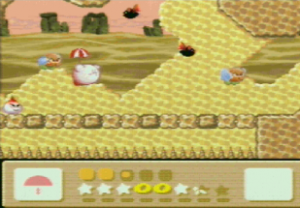
but 2 out of every 3 blocks crumble away as soon as you walk on them.
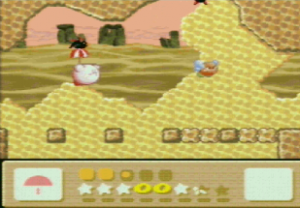
This creates a section that, when compared to all of the other sections previously discussed, is complex. The platforming required is very precise, since only every third block will support Kirby for any length of time. This is still not very difficult, since Kirby can float. Your attention is commanded by the lack of solid footing, but should you fall below, you are not instantly punished with damage; you can float back up. Enemies also prompt the player to act carefully, but avoiding damage from them is not difficult either, given their simplistic movement. They are carefully placed to get in your way; as you can see in the first of those two screenshots, if you choose to walk, you must confront the tick, and if you choose to fly, you must confront bronto burts and babuts. If you take on the tick, you must make sure you do not stand on a collapsing block for too long while doing so. If you take on the flying enemies, you must sustain flight while attacking enemies that move up and down. These enemies are not difficult to avoid or kill; their paths do not change, making a simple jump or attack easy enough to kill them. It’s this mix of thoughtful placement and forgiving circumstances that makes the game easy while still interesting.
The animals and heart missions complement this well.
Every animal introduces a new method of jumping; Rick can jump on enemies and wall jump, Nago allows you to triple jump while keeping your speed (Kirby’s float maneuver slows him down), Kine jumps high and runs fast, and so on. Through the animals, the game introduces a number of different ways you can move Kirby, all of which are distinct. This orients the platforming towards flow because every animal makes the platforming easier and faster. Kirby is given not only a wide variety of ways to attack enemies, but he’s also given a wide variety of ways to move around, allowing the player to enjoy the actual hopping and bopping of the game more than usual. The animals keep the pure platforming fresher.
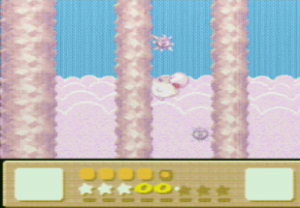
As for the heart missions, they often introduce thoughtful platforming. Pictured above is a section that Kirby can easily fly upwards through, but in order to earn a heart for the stage, the player must use Rick and wall jump upwards through the passage. The gordos are placed against the wall so that the player is required to be careful; rather than scale one wall, the player must switch sides to avoid hitting the gordos.
Of course, this approach has its flaws.
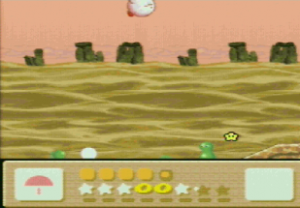
It’s easy to exploit Kirby’s ability to fly when level design isn’t claustrophobic. Here, if you don’t stick to the ground, you can just fly over everything. However, Kirby’s Dream Land 3 attempts to deter the player from this by making Kirby move slower while floating.
In short, there are two major approaches to Kirby platforming: a single mesh of simplicity and enemy confrontation, such as in Kirby’s Adventure, where the platforming creates enemy encounters that are simple with no sense of flow. The sequence of platforms is awkward, causing Kirby to approach enemies slowly, even if they have simple to avoid patterns. The other approach, found in Kirby’s Dreamland 3, separates the simplicity and enemy confrontation. When it is simple, the platforming shows a sense of flow, not allowing enemies to slow you. When the game thoughtfully places enemies in your way, the platforming aids them in its own thoughtful construction, creating a situation that is complex and interesting to confront.
There’s a lot of bias in that final paragraph, isn’t there?
comments powered by Disqus
All original content on VG Thought was written by Greg Livingston AKA Golem.